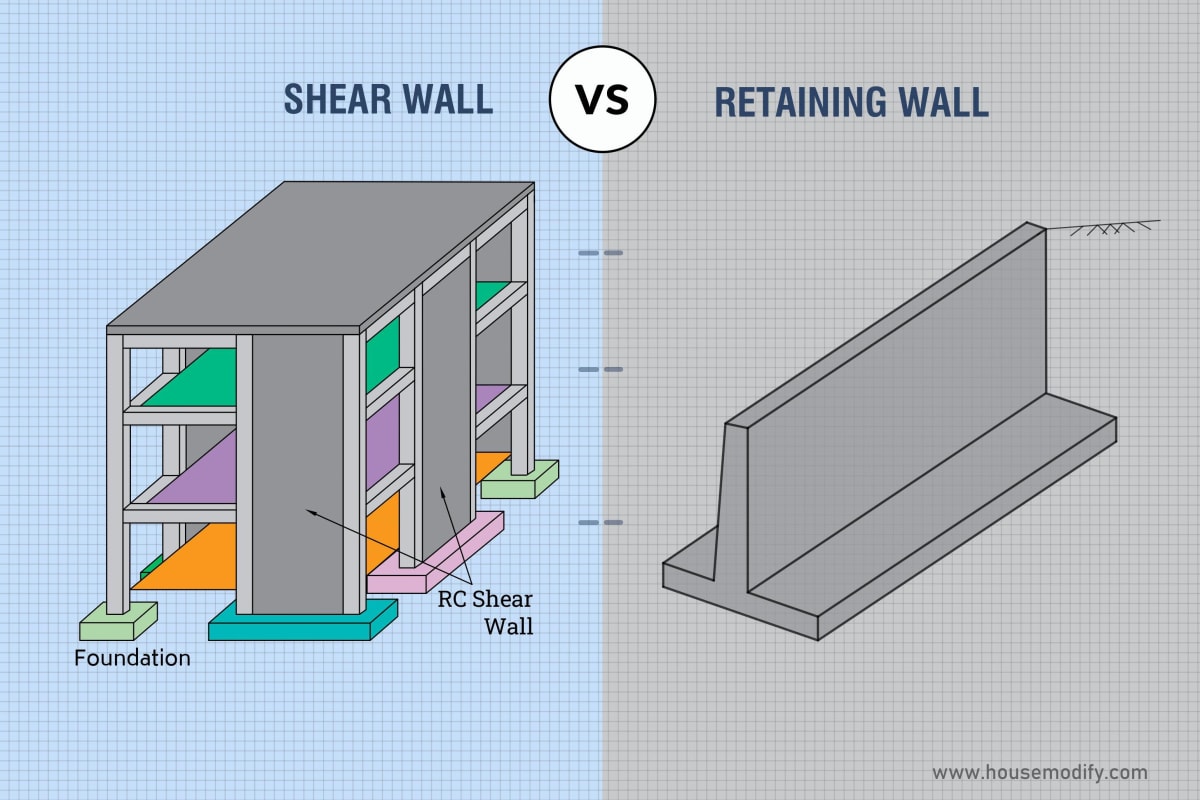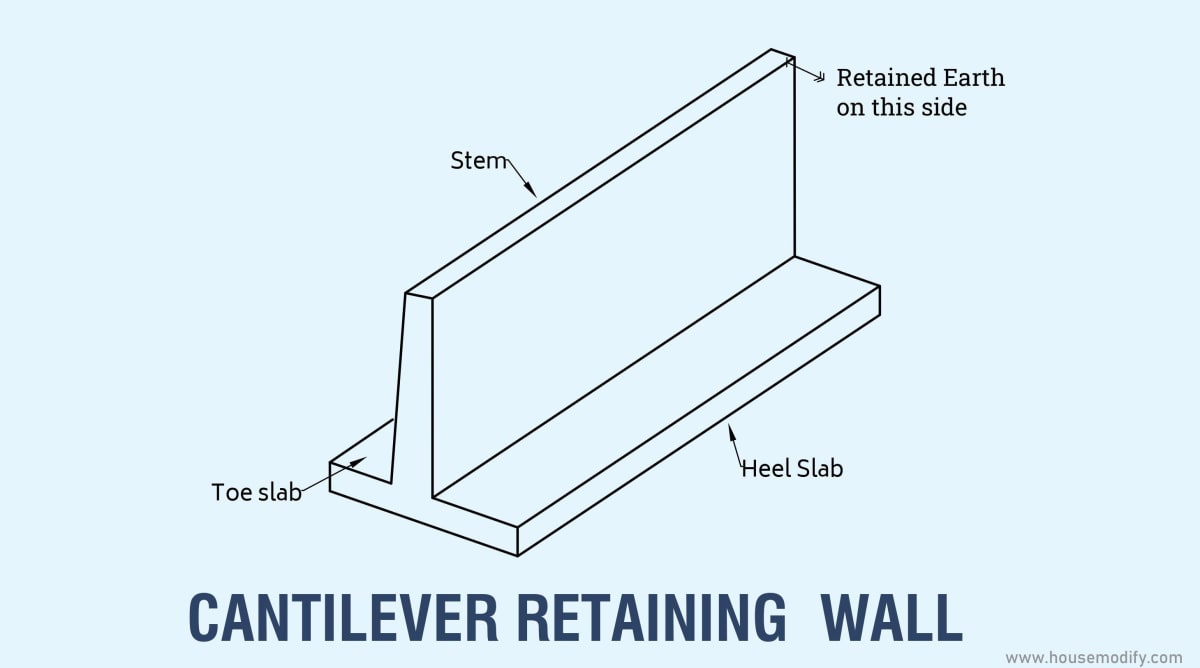Shear wall and retaining wall play vital roles in preserving the strength of buildings/soil.
A shear wall is a structural wall designed to resist horizontal forces, typically bracing elements in the superstructure of a building; the forces are parallel to the wall in this situation.
A retaining wall is a wall designed to carry the load of soil typically retained in an infrastructure.
At first glance, they may appear similar, but they are pretty distinct in performance.
Therefore, we focus on some significant differences between the shear walls and retaining walls to help you acquire knowledge about their value in construction.
Shear Wall Vs Retaining Wall:

What is Shear Wall?
A shear wall is a vertically loaded wall to bear the pressure of parallel-acting lateral forces.
From many directions, these lateral forces include earthquakes, windstorms, etc.
These forces should not be able to intensify much movement or crack that may occur due to average settlement or differential settlements.

Types of Shear Wall:
1. Reinforced Concrete Shear Wall:
In many modern residential buildings, reinforced concrete shear walls are frequently employed.
It enhances the vertical and the horizontal alignments.
2. Concrete Block Shear Wall:
Concrete Block Shear walls are reinforced with steel and concrete.
3. Steel Shear Wall:
This wall comprises a horizontal beam at the base, a boundary pillar, and an iron-plated wall surface.
4. Plywood Shear Wall:
It has panels of plywood with studs on the board.
Shearing stress occurs in plywood sheets while stud resists both tensile and compressional forces.
5. Mid-Ply Shear Wall:
A normal plywood wall has an added plywood sheet in the center, as well as some pairs of studs on both sides.
Advantages of Shear Walls:
Here are some of the critical benefits of shear walls as follows:
Increased structural stability:
These walls are instrumental in supporting wind and other seismic loads.
It assists in preventing the building from falling during such a severe event of the weather.
Cost-effective:
It offers an economical solution to the costs of erection and maintenance, hence more affordable as resistance against lateral loads.
Simple construction:
They are cheap to install and have no complicated links, and they don’t necessitate using heavy machinery that is associated with a higher cost.
Flexibility:
Since the shear wall design is flexible, these walls may adapt to many architectural demands.
Durability:
They are built using materials that are strong and resist wearing off, so they can last for years.
Energy efficiency:
Using shear walls, a building’s performance about energy needs can be improved, allowing for less power expenditure.
Aesthetics:
These shear walls contribute a crucial architectural dimension and also a certain visual quality to the building.
Disadvantages of Shear Wall:
Although shear walls have many benefits, they also have several drawbacks, which include:
Reduction in usable space:
They can also occupy the necessary floor area, particularly in restricted areas.
This offers a problem for the most effective application in building design.
Limited Flexibility:
Shear walls make interior spaces less flexible since they are difficult to move or eliminate.
This may lead to restrictions on the modifications that structures need to meet various demands.
Increased construction costs:
Compared to other types of lateral load-resisting components like braced frames, shear walls are relatively expensive to construct.
Complexity:
Shear walls necessitate careful design and details to ensure that lateral forces are correctly considered.
This may increase the complexity and cost of construction.
Aesthetic considerations:
Visual unattractiveness of shear walls becomes evident if their integration into the building’s visual appearance is neglected.
What is Retaining Wall?
The retaining wall is made from concrete blocks, and these are structural barriers that hold back soils or other materials at one end.
They are used to prevent the materials from collapsing towards a lower slope and create flat ground on the other sides.
It can be widely working on uneven fields aimed at leveling them up for different purposes.

Types of Retaining Walls:
1. Gravity Retaining Wall:
Gravity Retaining walls can resist lateral earth resistance.
2. Reinforcement Retaining Wall:
The use of reinforcement in retaining walls makes the retentive soils more solidified.
3. Cantilever Retaining Wall:
Some parts of the wall include the stem and the base slab.
4. Counterfort Retaining Wall:
It is similar to cantilever retaining walls; their design consists of counterforts – thin vertical concrete webs placed at equal distances along their back.
5. Buttress Retaining Wall:
A buttress retaining wall is a particular kind of counterfort wall.
Unlike most retaining walls that are built inside the backfill positioned on the slope’s surface.
6. Gabion Retaining Wall:
The wire is closely interconnected with these gabions, and they are packed with stones.
Gabion walls are seldom straight or vertical.
7. Crib retaining wall:
It consists of an arrangement of precast concrete or wooden boxes connecting.
8. Sheet Pile Retaining Wall:
A sheet pile retaining wall comprises a series of separate piles that are installed individually into the underlying soil.
9. Anchored Retaining Wall:
This retaining wall is anchored into the ground, rock, or another hard substance containing active soil forces.
10. Diaphragm Retaining Wall:
The diaphragm wall can be constructed through either reinforced concrete or sheet piling.
Advantages of retaining walls:
Retaining walls have several benefits, including:
Prevent soil erosion:
Soil erosion can be reduced whereby retaining walls are used to maintain debris that is either carried by winds or rains.
Create level surfaces:
Level surfaces can be created through the use of retaining walls on slopes.
Increase usable space:
It also helps maximize land use on steep lots.
Improve drainage:
It is possible to improve surface drainage and prevent water from flowing into dangerous areas, which may be hazardous during storms.
Reduce flood risk:
Retaining wall reduces the chances of floods by preventing water collection in some places.
Protect Structures:
Buildings are saved from landslides and floods by retaining walls.
Increase curb appeal:
Some of the retaining walls may give a polished look, adding interest as well as some curb appeal.
Also read: Difference between Shear Wall and Retaining Wall
Disadvantages of retaining walls:
Here are some of the significant disadvantages:
Cost:
The cost of significant projects involving the design and construction of retaining walls is very high.
Maintenance:
Retaining walls always require attention and repairs, so that they only break down some of the time.
Inspection of broken channels and channel repair work in drainage systems.
Risk of Failure:
When done improperly, retaining walls can collapse and result in catastrophic damage or injury.
Aesthetics:
Some people perceive retaining walls as ugly and a disturbance of nature.
What is the Difference between Shear Wall and Retaining Wall?
Now, let’s directly compare the critical differences between shear wall and retaining wall as follows:
| Feature | Shear Wall | Retaining Wall |
|---|---|---|
| Purpose | Shear wall resists lateral forces such as wind and earthquake. | Retaining wall retains soil and prevents erosion. |
| Location | Usually, these walls are located at the perimeter of the building. | Usually, these walls are located at the boundary of the property. |
| Shape | Rectangular or square. | Varies based on the shape of the terrain. |
| Thickness | Thicker at the base and thinner at the top. | Uniform thickness throughout. |
| Material | Concrete, masonry, or steel. | Concrete, masonry, or stone. |
| Reinforcement | Reinforced with steel bars. | Reinforced with steel bars. |
| Design | Designed to resist lateral forces. | Designed to resist lateral forces and soil pressure. |
| Construction | Constructed before the building is erected. | Constructed after the excavation is done. |
| Appearance | Not visible from outside. | Visible from outside. |
Also read: Difference between Normal Wall and Retaining Wall
Frequently Asked Questions (FAQs):
What is the primary function of a shear wall?
The shear wall is the primary support system that resists lateral forces as well as the essential factor for the stability of any building.
Can a retaining wall also act as a shear wall?
No, retaining walls are not constructed for load-bearing pressures.
Is there an eco-friendly alternative to building retaining walls?
There are retaining walls that use recycled wood or ecological concrete elements.
How do I determine the ideal location for a retaining wall?
Retaining walls depend on the type of ground and their function.
Talk to your landscape consultant.
Can we combine shear walls and retaining walls for the same project?
Yes, a structure may require these two walls.
These are retaining walls to retain soil and shear walls for structural support.
Also read: Difference between Breast Wall and Retaining Wall
Conclusion:
Shear wall and retaining wall is essential components of construction and landscaping.
Shear walls are vertical structures that provide lateral support for buildings against lateral forces in the vertical direction, and a retaining wall is a horizontal or slightly inclined system designed to prevent soil erosion from occurring.
It is essential for engineers, architects, and anyone working on building and landscape projects to understand these differences.
Section Under: Retaining Walls









Hey there, I appreciate you for posting such an informational article. It helps me to clearly see the difference between a retaining wall and a shear wall. Both walls are functional, and they also come in various types. Thank you so much again for sharing your idea about these walls. In addition to the details, you also included a comparison table, making your content understandable. After reading your article, I got interested in starting a retaining wall project.